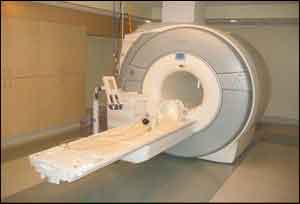- Home
- Editorial
- News
- Practice Guidelines
- Anesthesiology Guidelines
- Cancer Guidelines
- Cardiac Sciences Guidelines
- Critical Care Guidelines
- Dentistry Guidelines
- Dermatology Guidelines
- Diabetes and Endo Guidelines
- Diagnostics Guidelines
- ENT Guidelines
- Featured Practice Guidelines
- Gastroenterology Guidelines
- Geriatrics Guidelines
- Medicine Guidelines
- Nephrology Guidelines
- Neurosciences Guidelines
- Obs and Gynae Guidelines
- Ophthalmology Guidelines
- Orthopaedics Guidelines
- Paediatrics Guidelines
- Psychiatry Guidelines
- Pulmonology Guidelines
- Radiology Guidelines
- Surgery Guidelines
- Urology Guidelines
Gadolinium-enhanced MRI improves diagnostic accuracy in polymyalgia rheumatica

ATLANTA -- Researchers have found that gadolinium-enhanced magnetic resonance imaging (MRI) in shoulders of patients with polymyalgia rheumatica may contribute to more accurate diagnosis and prediction of recurrence. Gadolinium-enhanced MRI displayed capsulitis, rotator cuff tendinitis, and focal osteitis in shoulders that was relatively specific to patients with polymyalgia rheumatica .The new research findings shall be presented this week at the 2019 ACR/ARP Annual Meeting(Abstract #1161).
Polymyalgia rheumatica (PMR) is a chronic musculoskeletal disorder that causes aching and stiffness about the upper arms, neck, lower back and thighs.It affects adults over the age of 50 and may also occur with giant cell arteritis.
PMR is clinically diagnosed based on symptoms, but accurate diagnosis is difficult because the symptoms may occur in many other rheumatic diseases. Recent research suggests that ultrasonography used in shoulder joints could detect findings specific to PMR, such as biceps tenosynovitis and subdeltoid bursitis. While MRI may visualize bone and muscle lesions, its application in PMR has not been established, so this cross-sectional, follow-up study evaluated gadolinium-enhanced MRI findings in the shoulder of PMR patients to assess whether it could improve diagnostic accuracy and prognosis prediction.
"The diagnosis of PMR remains challenging. Bird's Classification Criteria composed of the combination of clinical symptoms is highly sensitive to detect PMR but is low in specificity and requires careful diagnosis of exclusion," says Kazuro Kamada, MD, a rheumatologist at Tomakomai City Hospital in Japan, and the study's lead author. "The EULAR/ACR Provisional Classification Criteria using ultrasound findings improved specificity, but the sensitivity was not enough. So, we need a new diagnostic tool with high specificity and sensitivity for PMR."
Participants in the study included 175 patients with bilateral shoulder pain who fulfilled the Bird classification criteria for PMR between June 2012 and June 2018 at Tomakomai City Hospital. Out of these, 137 patients received both gadolinium-enhanced MRI and ultrasonography on their shoulders. At least two rheumatologists diagnosed PMR in 58 of the patients, and independent radiologists evaluated their MRI and ultrasonography findings. Patients diagnosed with PMR were prescribed 20 mg/day of prednisone initially, and then this dose was tapered after remission. The researchers followed patients until June 2019 to determine any recurrences of PMR symptoms.
The MRI findings in the study's patients included enhancement of joint capsule, rotator cuff tendon or biceps tendon, synovial hypertrophy, shoulder joint effusion, enhancement of glenohumeral joint, and/or focal or diffuse bone edema in the humerus heads. These findings showed that PMR patients had significantly frequent enhancement of joint capsule or rotator cuff tendon and focal bone edema in humerus heads. When the researchers used these three findings in combination to diagnose PMR, MRI had 76 percent sensitivity and 85 percent specificity, higher compared to ultrasonography findings, which had 50 percent sensitivity and 72 percent specificity. During follow-up, 24 or 44 percent of the patients had a recurrence of PMR. Patients with recurrent PMR were younger in age, had less enhancement of their rotator cuff tendon and more synovial hypertrophy findings on their MRI.
These findings lead the study's authors to conclude that Gadolinium-enhanced MRI of the shoulder can play a useful clinical role in patients with PMR, contributing to diagnostic accuracy and prediction of recurrence in patients with this rheumatic disease.
"Rheumatologists will diagnose PMR with confidence using gadolinium-enhanced MRI with high sensitivity and specificity, which will lead to decreasing misdiagnosis of PMR," says Dr. Kamada. "Moreover, rheumatologists can consider using disease-modifying anti-rheumatic drugs from the early stage for PMR patients if recurrences can be predicted by gadolinium-enhanced MRI. We are going to validate the results in a larger cohort next in order to optimize and standardize the gadolinium-enhanced MRI procedure for PMR to apply in real-world clinical practice."
American College of Rheumatology

Disclaimer: This site is primarily intended for healthcare professionals. Any content/information on this website does not replace the advice of medical and/or health professionals and should not be construed as medical/diagnostic advice/endorsement or prescription. Use of this site is subject to our terms of use, privacy policy, advertisement policy. © 2020 Minerva Medical Treatment Pvt Ltd